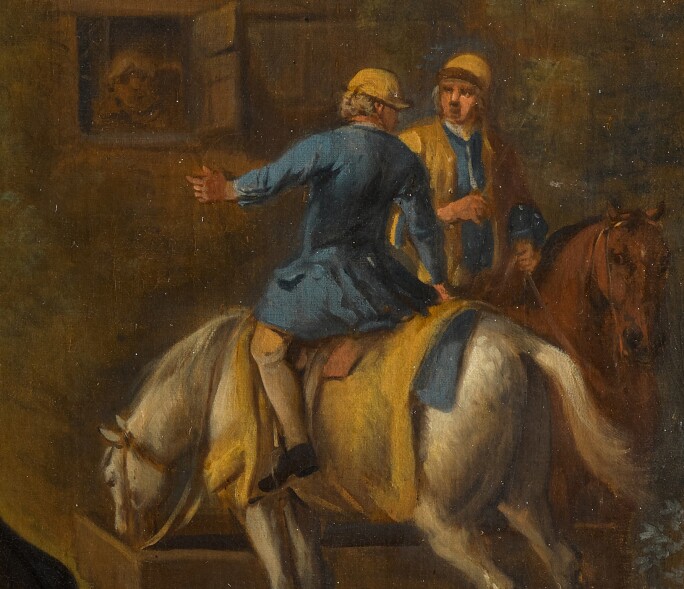“The fastest horse that was ever bred in the world”

The first truly great racehorse in the history of The Turf, known as 'the fastest horse that was ever bred in the world’, Flying Childers was bred by Colonel Leonard Childers of Cantley Hall, Doncaster in 1714. Famously undefeated, he was sired by the Darley Arabian, who had been imported into England circa 1704 from Aleppo, out of Betty Leedes, a granddaughter of the celebrated Godolphin Arabian. Together with the Byerley Turk, the Darley Arabian and the Godolphin Arabian are two of the three foundation Arabian sires from whom all modern Thoroughbred racehorses in the world descend. Collectively they are famously known as the three pillars of stud book.

Foaled in 1714, with a distinctive white blaze and four white stockings, Flying Childers was a large racehorse for his time, growing to 15.2 hands in full maturity. He was sold as a yearling to William Cavendish, 2nd Duke of Devonshire (1672-1729), in whose distinctive blue and yellow livery the groom and the two mounted figures on the right in this painting are shown. His first race was at Newmarket, on 26 April 1721, as a six-year-old, in which he defeated the Duke of Bolton’s Speedwell, in a match over four miles on the Round Course in six minutes and forty seconds, carrying 9st and 2lbs. Later that year he beat Almanzor, also by the Darley Arabian, and a mare called Betty Brown in a three horse match on the same course, when he is said to have covered nearly a mile in a minute, with each stride covering twenty-five feet. In 1722 he defeated Chaunter, again at Newmarket, before winning a trial at York against the celebrated runner Fox by a quarter mile. Known alternately as Devonshire Childers, following an exceptional racing career in which he was never beaten, Flying Childers was retired to stud at Chatsworth. The Duke of Devonshire was frequently offered great sums of money for him, reputedly including one of the horse’s weight in gold crowns, but they were all refused and he remained at Chatsworth until his death in 1741, aged 26. He was a successful sire, producing a number of notable runners; including the splendidly named Spanking Roger, who had a highly successful racing career running for Sir Edmund Bacon; Blacklegs, another leading sire; and Blaze, whose racing successes included winning three King’s Plates and who himself became the dame sire of the great Herod.
“He both drew and coloured with consummate skill, fire and truth”
John Wootton (1682–1764) was the leading sporting and landscape painter in England in the first half of the eighteenth century. A forerunner to the great sporting art of George Stubbs half a century later, he was also responsible for making English landscape painting a credible and popular genre in itself, paving the way for subsequent artists such as Richard Wilson, Thomas Gainsborough, J. M. W. Turner, John Constable and Richard Parkes Bonington, who transformed the genre into one of the greatest achievements of British art. Wootton was regarded by his contemporaries as without rival as a sporting artist, and he enjoyed a network of patronage that seems to have been unaffected by family loyalties or party politics. His Royal benefactors included George II and his estranged son, Frederick, Prince of Wales. Sir Robert Walpole, who commissioned Wootton for paintings to decorate the walls of both Houghton Hall and Downing Street (including a portrait of his favourite Italian greyhound Patapam), was as happy to patronise the artist as were members of the Opposition, whilst Walpole's son, Horace, not usually known for agreeing with his father on aesthetic matters, thought his work of 'very capital manner', admiring the way 'he both drew and coloured with consummate skill, fire and truth'.1 The younger Walpole was even moved to comment that Wootton's landscapes 'approached towards Gaspar Poussin and sometimes imitated happily the glow of Claude Lorrain'. This remarkable reputation was attested to by George Vertue, who noted that the artist 'was in great vogue & favour with many persons of ye greatest quality'.2 Included among Wootton's most notable patrons were the Dukes of Beaufort, Devonshire, Newcastle and Bedford, as well as the Dukes of Bolton, Rutland, Richmond and Leeds (both the 3th and 4th Dukes). The munificent Edward Harley, 2nd Earl of Oxford, commissioned over forty paintings from him for Wimpole Hall and he painted grand cycles of work at both Longleat and Althorp, as well as for the influential banker, Henry Hoare, at Stourhead.

1 H. Walpole, Anecdotes of Painting in England, vol. IV, London 1762–71, pp. 119–20.
2 G. Vertue, 'Notebooks, Volume III', The Walpole Society, vol. XXII, Oxford 1934, p. 34.